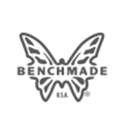Pocket Knife Locks: Linerlock vs. Framelock
1st Sep 2021

All things considered, if you pick up a locking pocket knife there is much better than a good chance that it locks either by a liner lock or a frame lock. Although there are many other kinds of locks out there (collar locks, lock backs, Tri-Ad locks, AXIS locks, and others), because liner locks and frame locks are relatively easy and affordable to make, they’re found on the majority of folding, locking knives. But is one better than the other?
How a Linerlock Works
Folding knives with a liner lock mechanism typically have a frame that consists of separate handle scales inside of which the liners are contained. On one side of the pocket knife - almost always on the left side of the knife (looking down at the open knife, edge-on) one of the liners is tempered to spring inward underneath the bottom of the shoulder when the blade is deployed.
The blades of knives with liner lock mechanisms are milled at an angle to engage the bottom of the liner, which holds the blade open under tension. They’re easy to open and engage, and when adjusted properly, they don’t allow any play in the knife, either back to front or side to side.
To disengage a liner lock, you simply press the liner back over into place, freeing it from the bottom of the knife’s shoulder. The knife can then be folded and stowed.
Pros
There are a lot of advantages to a pocket knife that contains a liner lock mechanism, including the following:
-Knives with liner lock mechanisms can often be easily and efficiently deployed.
-Most knives that have liner locks also have thumb studs or thumb holes, enabling the knife to be opened with one hand.
-Even pocket knives that have nail nicks and cannot be deployed with one hand can still be closed with one hand.
-Most folding knife liner lock mechanisms are reasonably strong, although they are not the strongest locking mechanism.
Cons
However, despite the list of advantages of liner locks, they have some pronounced drawbacks:
-The leaf of metal that constitutes the lock of the mechanism is prone to deformation under stress. Rough tasks like batoning (which can result in undue stress on the blade, the knife handle, and the lock) can cause the locking leaf to bend, basically ruining the knife.
-While one of the advantages of a liner lock is that you can close it with one hand, you must practice extra care when doing so because your fingers will be in line with the path of the edge as it closes.
-Liner locks may also disengage if a user is twisting the handle very vigorously.
How a Framelock Works
Frame locks are extremely similar to liner locks in operation and offer many of the same advantages and disadvantages with a few key differences. The principle of operation for frame locks and liner locks is the same; with a frame lock, the leaf of metal that springs inward to engage the base of the blade is contiguous with the frame of the knife. For this reason, frame lock knives are almost exclusively made with knives with metal alloy frames.
Operation in all other aspects is identical, so what it comes down to is a small list of relative strengths and weaknesses.
Pros
Frame locks have some distinct advantages, most of which they share with liner locks:
-They are also easy to open with one hand, and simple to engage.
-They can be disengaged with one hand as well.
-However, despite the fact that they operate via the same principle as liner locks, there is much more metal stock behind most frame locks. This means that they are typically structurally much stronger and resistant to failure. You can’t bang on the blade, but they’re less prone to deformation.
Cons
-Frame locks, like liner locks, will require you to put your fingers in the path of the blade’s edge in order to close it. You must exercise caution when disengaging a frame lock.
-Like liner locks, if you torque the handle of a frame lock, you may risk inadvertently disengaging the lock; however, because frame locks tend to be sturdier, there is usually less of a chance of this occurring.
Which Is Better?
Stylistically, it really comes down to a matter of personal preference whether you prefer liner locks or frame locks. They both, within their reasonable limits, are perfectly useful knife locks.
While frame locks are not necessarily “better” than liner locks, they do have one distinct advantage in that they tend larger and thicker, locking the blade open behind a larger, stronger bar of metal.
Either way, there are plenty of serviceable, folding pocket knife designs out there featuring quality stainless steel blades for both prolonged edge retention and corrosion resistance. They may even sport other features, such as spring-assisted opening mechanisms and reversible pocket clips. Ideal for everyday carry tasks like opening envelopes and cutting rope, a quality knife may have either of these lock types or even another.
If you’d like our personal recommendation for a new EDC knife with a strong lock, just get in touch with us at WhiteMountainKnives@gmail.com and we would be happy to assist.








